8 Early Spring White Flowering Trees (and one to avoid)
Whether it's a Dogwood tree in full bloom or a Magnolia tree showing off its large petals, there's something about early spring white flowering trees that just seems to symbolize hope and renewal. So if you're looking for a little bit of inspiration this spring, make sure to take some time to appreciate these early blooming trees!
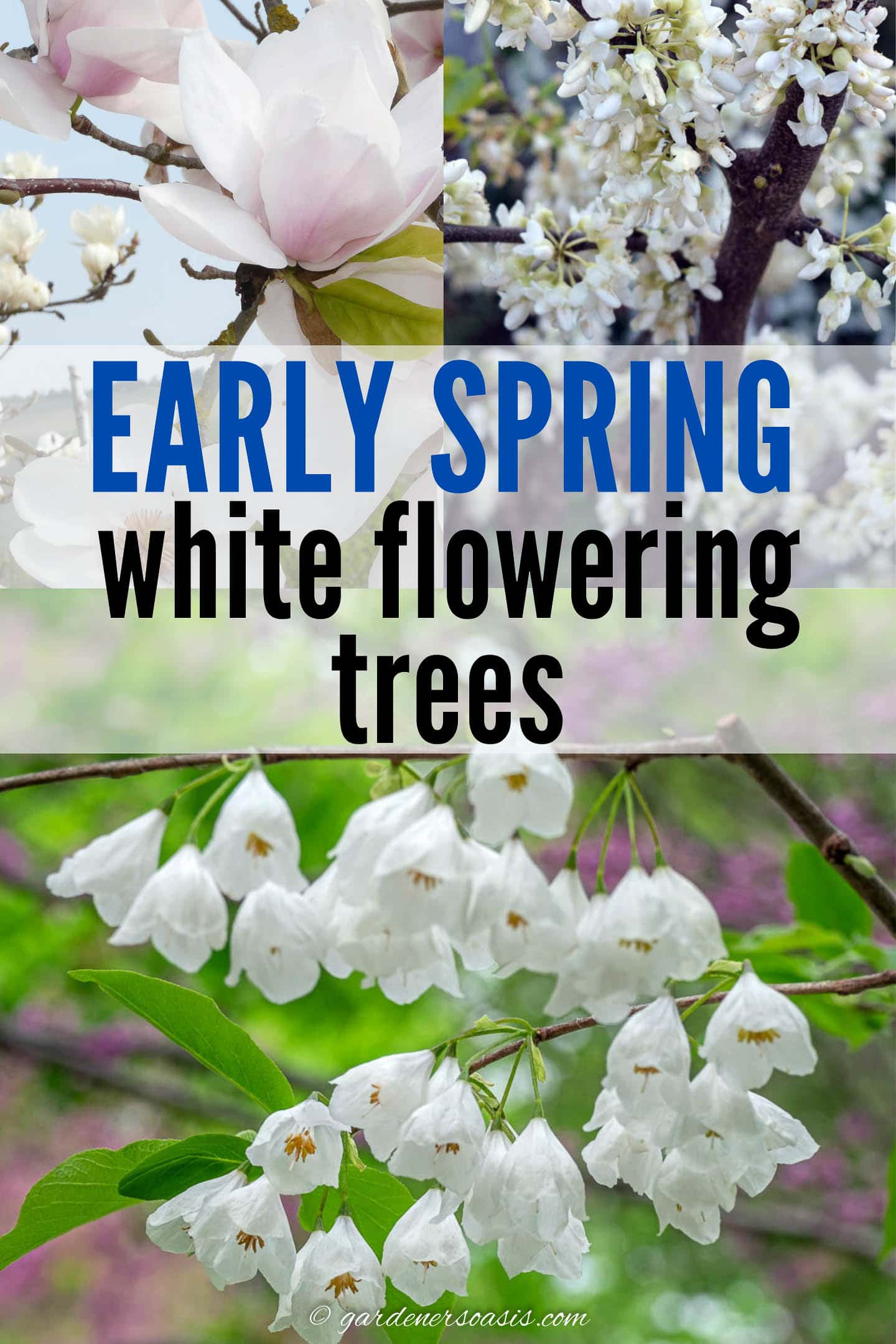
Can you believe it's already spring?
The days are finally getting longer and warmer. And the early spring flowers are starting to brighten up the garden.
But to me it always feels like spring is really here when the early spring trees are covered in blooms.
And many of the white-flowering varieties seem to be the first to put on a show.
So if you are fond of white blooms and are in the market for a statement tree, I hope you find the following list helpful.
1 | Florida Dogwood (Cornus Florida)
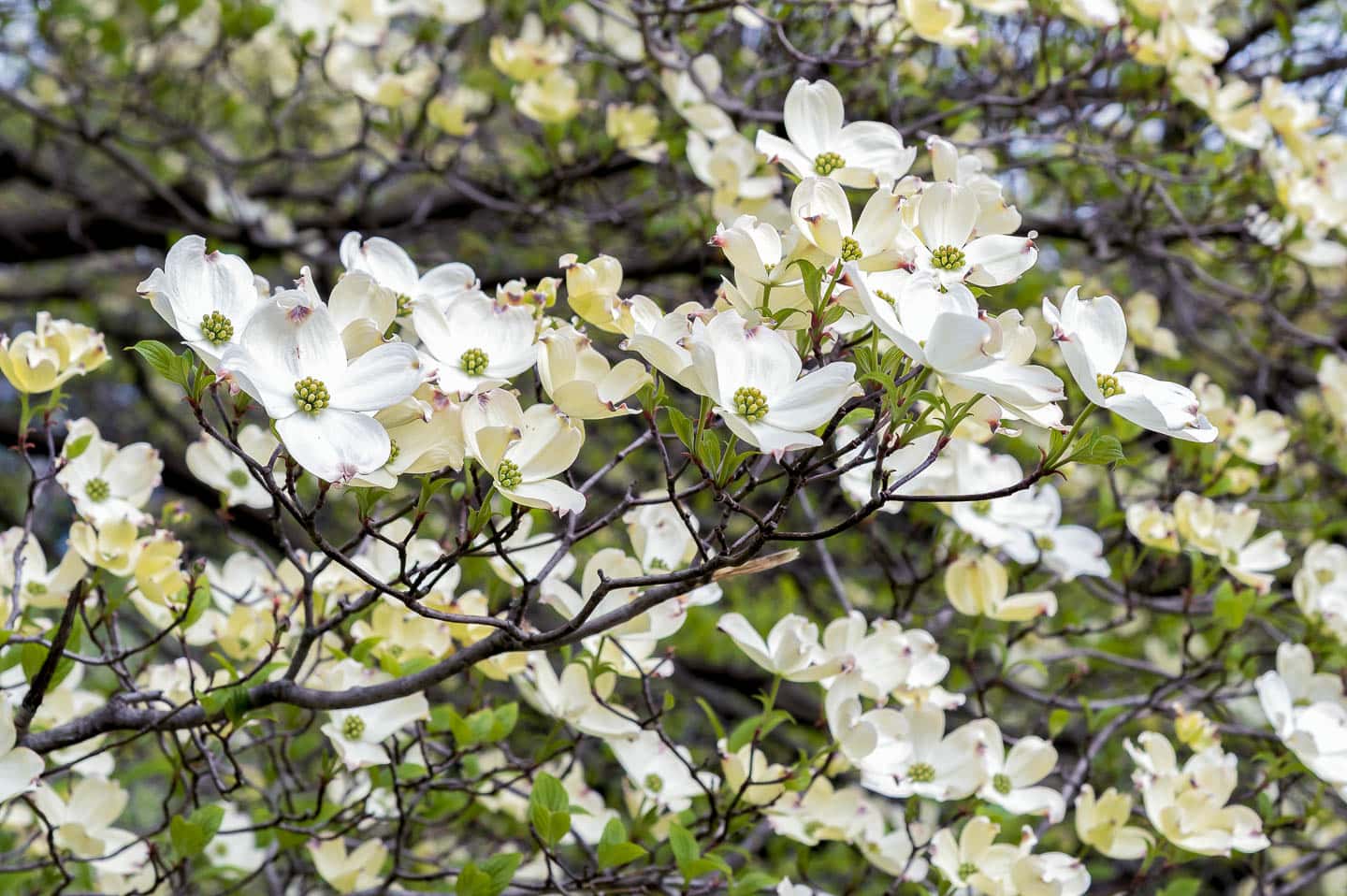
Zone: 5 to 9
Exposure: part shade
Height: 15′ to 30′
Width: 15′ to 30′
Bloom time: early spring
Bloom color: white with green center
In my opinion, nothing beats the sight of the North American native dogwoods in bloom amid the brown of forests in early spring. Talk about renewed hope and joy!
Cornus Florida is a four season interest small tree that produces masses of four pointed white blossoms with green centers in the early spring.
The blooms precede the foliage.
Then, in summer, they give way to bright red berries that are readily devoured by birds and squirrels.
In the fall, the foliage turns a crimson/ purple, and winter interest is provided by the gray alligator-like patterned bark.
This showy tree prefers acidic soil, is very low maintenance and is deer tolerant.
2 | Saucer Magnolia (Magnolia x Soulangeana)
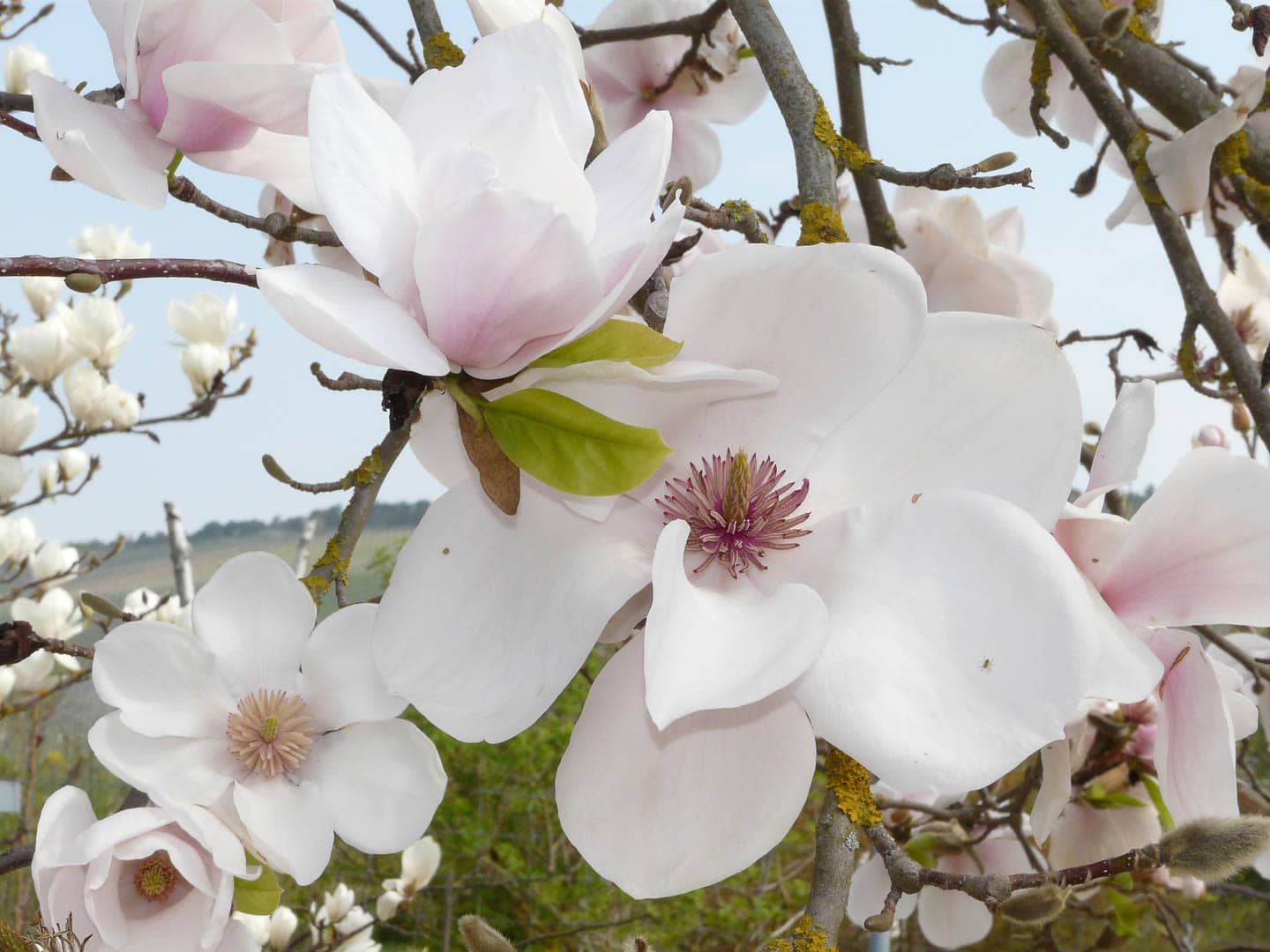
Zone: 5 to 9
Exposure: full sun, part sun
Height: 20′ to 25′
Width: 20′ to 25′
Bloom time: early, mid spring
Bloom color: white with purple and pink shading
Nothing is as majestic as the 10″ goblet-shaped blooms on a saucer magnolia tree.
The fragrant white flowers appear before the foliage and have pink and purple markings on the outside.
They also attract birds and butterflies.
The mid-green leaves turn golden brown in the fall.
The smooth silver trunks supply winter interest.
Magnolias like acid, well-drained soil, and can also be grown as a multi-stemmed shrub.
3 | Anise Magnolia (Magnolia salicifolia)
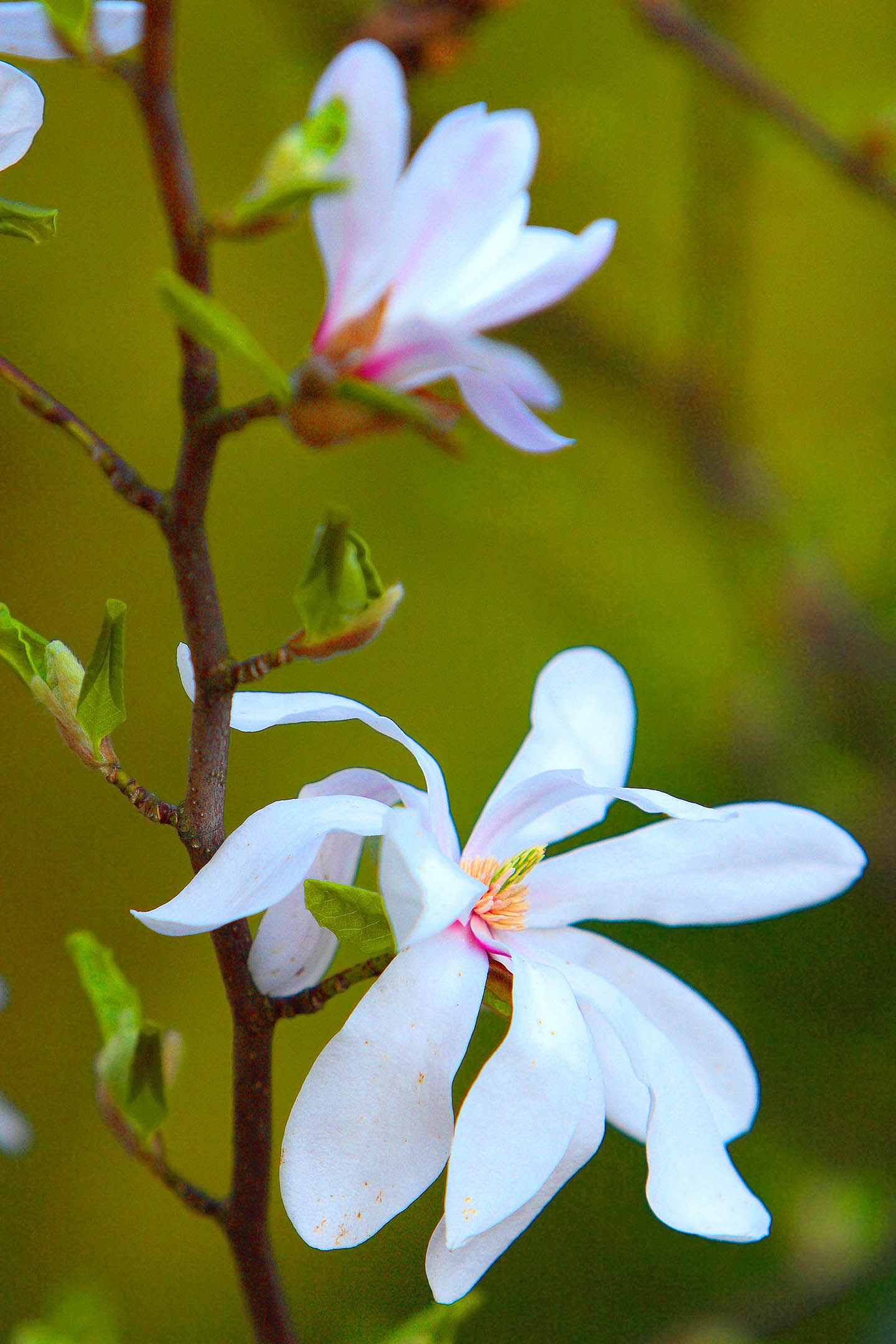
Zone: 6 to 9
Exposure: sun, part sun
Height: 30′ to 50′
Width: 30′ to 50′
Bloom time: early spring
Bloom color: white with pink at base
The Anise Magnolia is another one of my favorite trees with white blossoms in early spring.
3″ to 6″ tulip shaped white, pink tinged blossoms, that smell like anise, grace this small deciduous tree before the leaves emerge.
The leaves and gray trunk are also aromatic when scratched.
The ovate willow-shaped leaves of Anise Magnolia start out coppery/red with white undersides and turn golden yellow in the fall.
Plant this tree in acidic, well drained soil.
Like all early blooming magnolias, the flowers are susceptible to late frosts.
It attracts birds and butterflies.
Recommended variety: M. salicifolia ‘Wade's Memory' — a multitude of 7″ fragrant, white blossoms in early spring. Golden fall color. A popular award winner, for zones 5 to 8.
4 | Flatwoods Plum (Prunus umbellata)
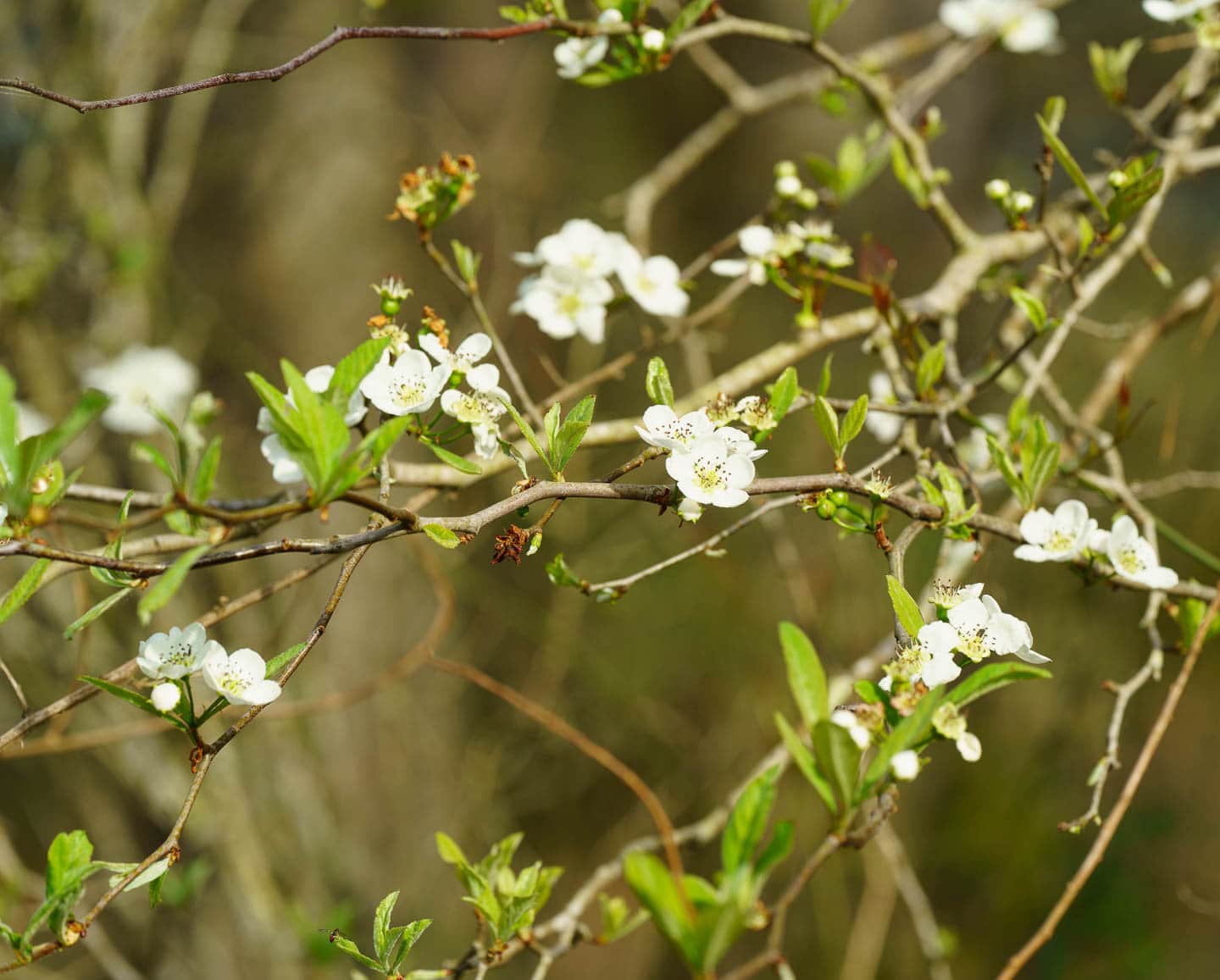
Zone: 8A to 9B
Exposure: full sun, part sun
Height: 12′ to 20′
Width: 15′
Bloom time: late winter, early spring
Bloom color: white to cream
Flatwoods plum is a deciduous small tree that is native to the southeastern USA.
It is grown mainly for the profusion of small white flowers that cover the branches in early spring.
The blooms are followed by purple, edible fruit that can be used to make jams and jellies if the wild life doesn't eat it first.
Suckering is not a problem. In fact, this species is easy and low maintenance.
If grown in sandy soil, it will need more water and shade. Otherwise it is drought tolerant.mAnd also attracts pollinators and birds.
Source: www.naturehills.com
5 | Saskatoon Serviceberry (Amelanchiea)
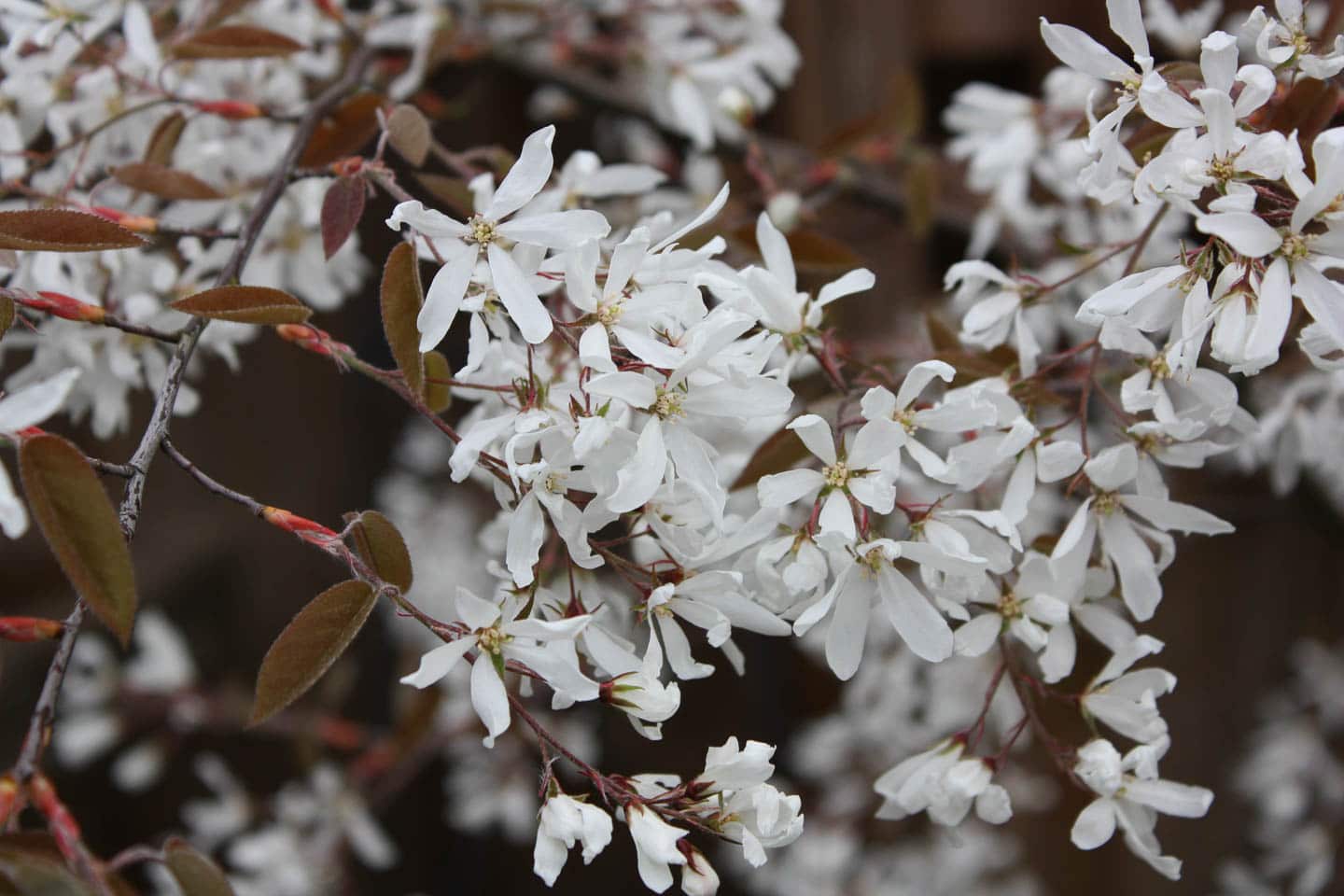
Zone: 2 to 8
Exposure: sun, part sun
Height: 12′ to 20′
Width: 10′
Bloom time: early to mid spring
Bloom color: white
The Saskatoon deciduous bush or tree is an American northwest native that is covered in masses of white flowers in early spring.
It is also highly prized for its dark blue/purple berries that ripen in mid summer , and are comparable to blueberries in taste and antioxidant value.
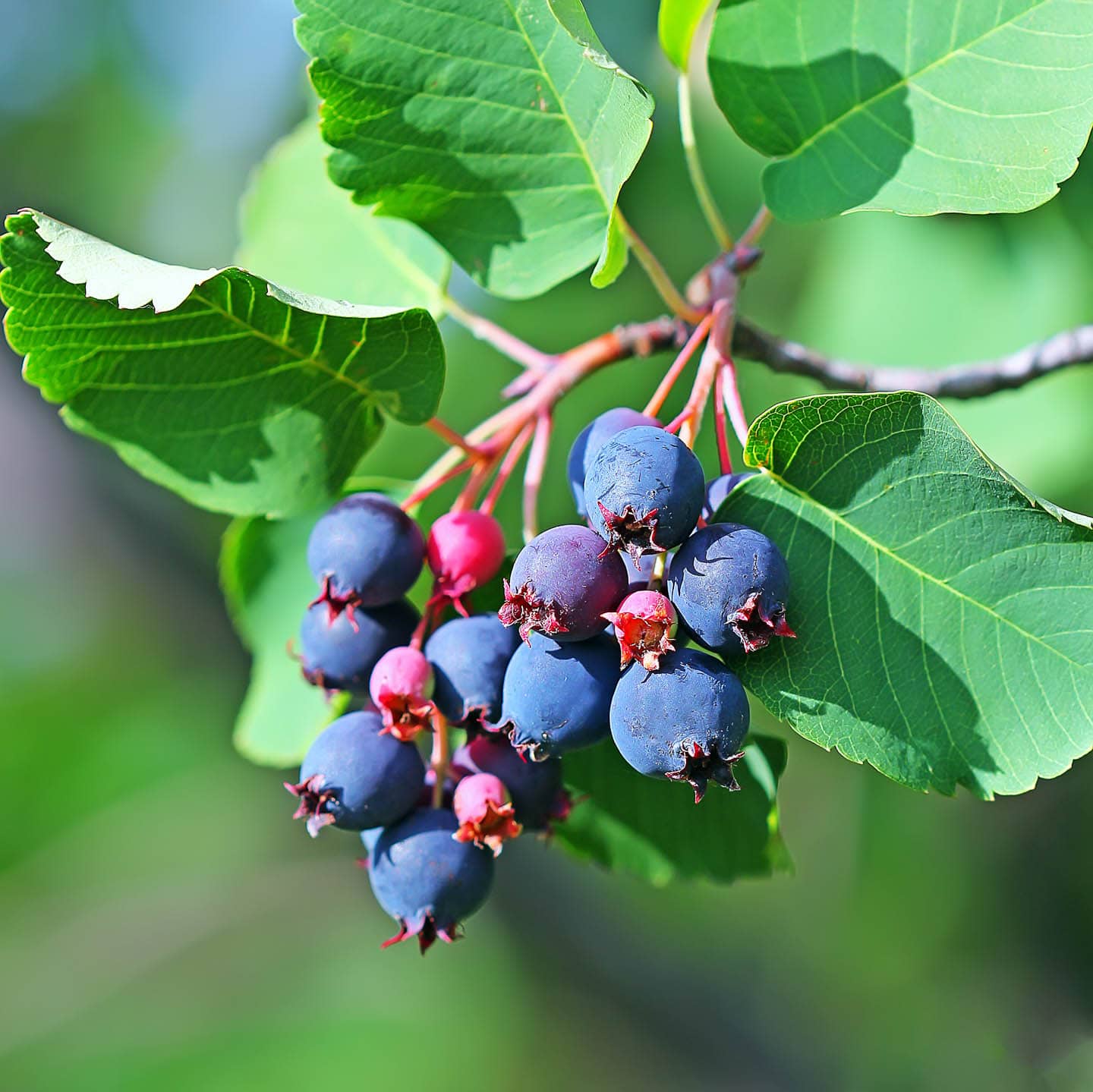
Our North American natives used it to make pemmican and other sustainable foods. The berries are delicious when made into jams, pies, wine, etc. or added to granola.
In the fall, the leaves turn a fiery orange/red.
And its dark gray bark with red-tinged fissures puts on a show in the winter, too. So this truly is a tree with all-season interest.
Saskatoons like moist, rich soil and are a good addition to attract birds to the garden.
The one growing in my garden acts as an overstory for the raspberry patch. I find that it is a low maintenance little tree.
Variety: Saskatoon serviceberry ‘Northline' — A self fertile shrub version growing 5′ to 7′.
Source: nativefoodsnursery.com
www.coldstreamfarm.net
6 | White Redbud (Cercis Canadensis)
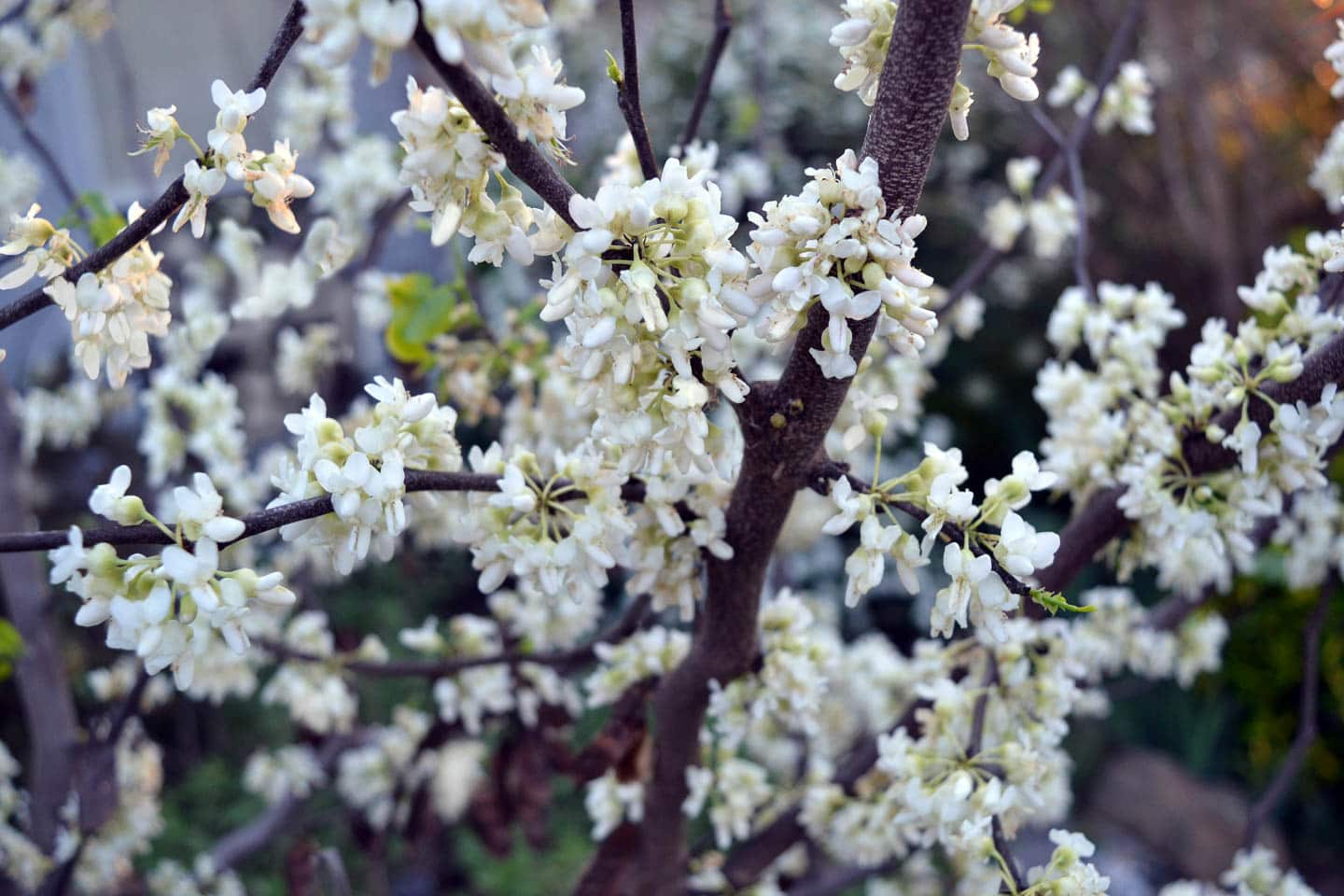
Zone: 4 to 9
Exposure: full sun, part shade
Height: 15′ to 25′
Width: 15′ to 25′
Bloom time: early spring
Bloom color: white
Cercis alba ‘Royal White' looks wonderful, in spring, as a specimen or lining a street, when its white blooms burst forth and cover the bare branches. What a magnificent show!
This small compact deciduous tree, that withstands deer, clay soil and black walnut, has blue-green leaves that turn yellow in the fall.
Plant young specimens in deep well-drained soil.
It does not like to be transplanted or have its feet wet.
To keep redbud healthy, prune out dead branches, water and fertilize regularly.
Varieties: Cercis canadensis ‘Texas White'
Source: www.nvknurseries.com
www.greenleafnursery.com
7 | Carolina silverbell (Halesia tetraptera)
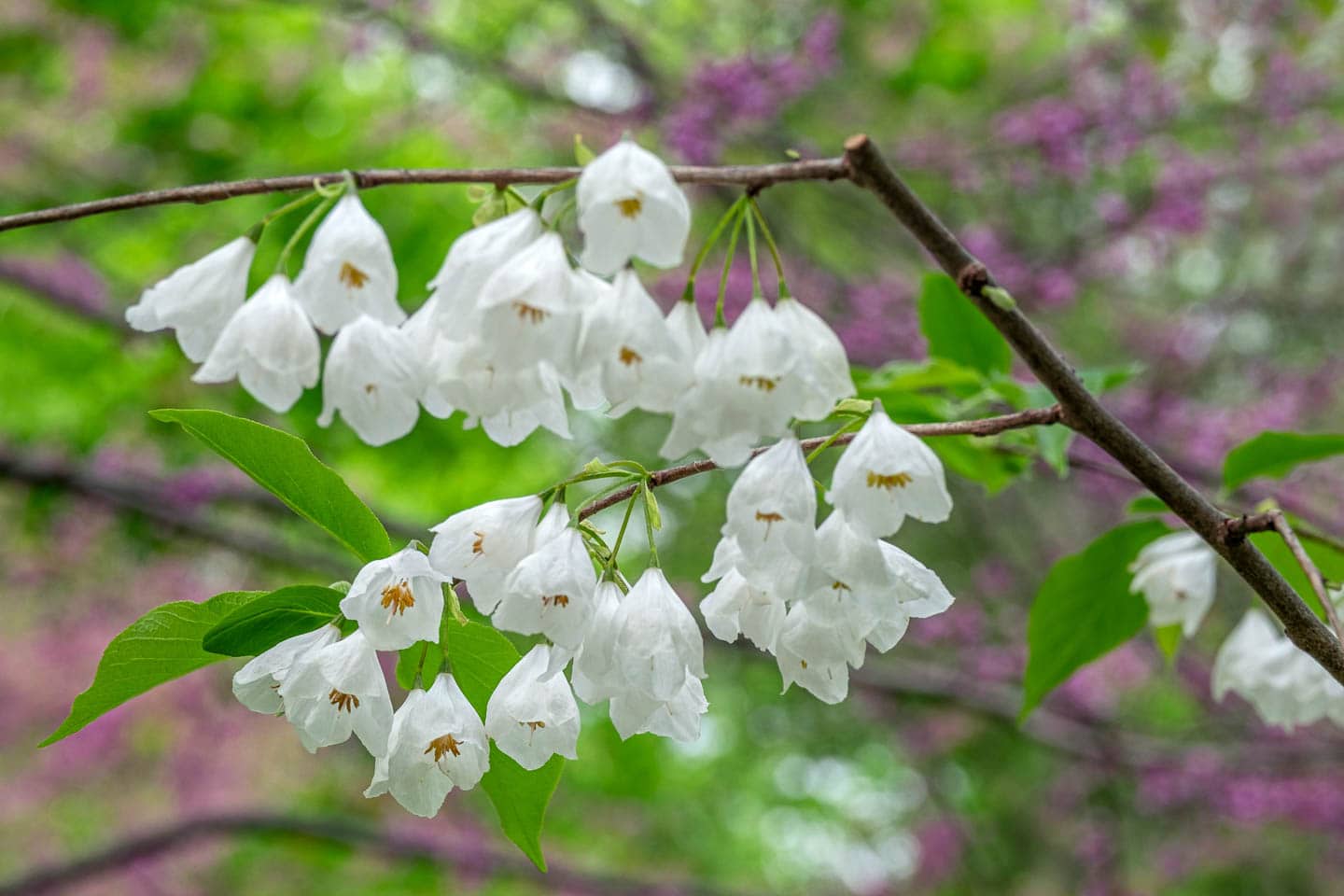
Zone: 4 to 8
Exposure: part shade
Height: 10′ to 40′
Width: 25′ to 35′
Bloom time: early spring
Bloom color: white
The Carolina silverbell is native to the Eastern USA. This small deciduous tree is best grown in the understory so that it gets the part-shade it loves.
Clusters of bell-like flowers, that hang from last year's branches, are best appreciated when looked at from below. This tree has nice yellow fall color. The oblong, brown seeds provide winter interest and bird feed. There are even variegated leaf varieties.
Amend the soil with lots of organic matter before you plant. They like acidic well-drained soil. Fertilize in the spring with rhododendron fertilizer and mulch. Silverbell is somewhat drought tolerant once established.
It does not transplant well. Clemson university suggests that you will have the best success if you buy containerized specimens.
This lovely little tree attracts hummingbirds, butterflies, birds and bees and is a host plant for many caterpillars.
Variety: H. diptera — 2 winged small round tree that reaches a height of 20′ to 30′
H. diptera ‘ magniflora‘ — larger white flowers, very floriferous.
H. tetraptera ‘monticola' (mountain silverbell) — flowers are larger than the Carolina silverbell.
H. ‘Wedding Bells' — has a rounded form and grows to 20′.
Source: woodlawntrees.com
8 | Yoshino cherry (Prunus x yedoensis)
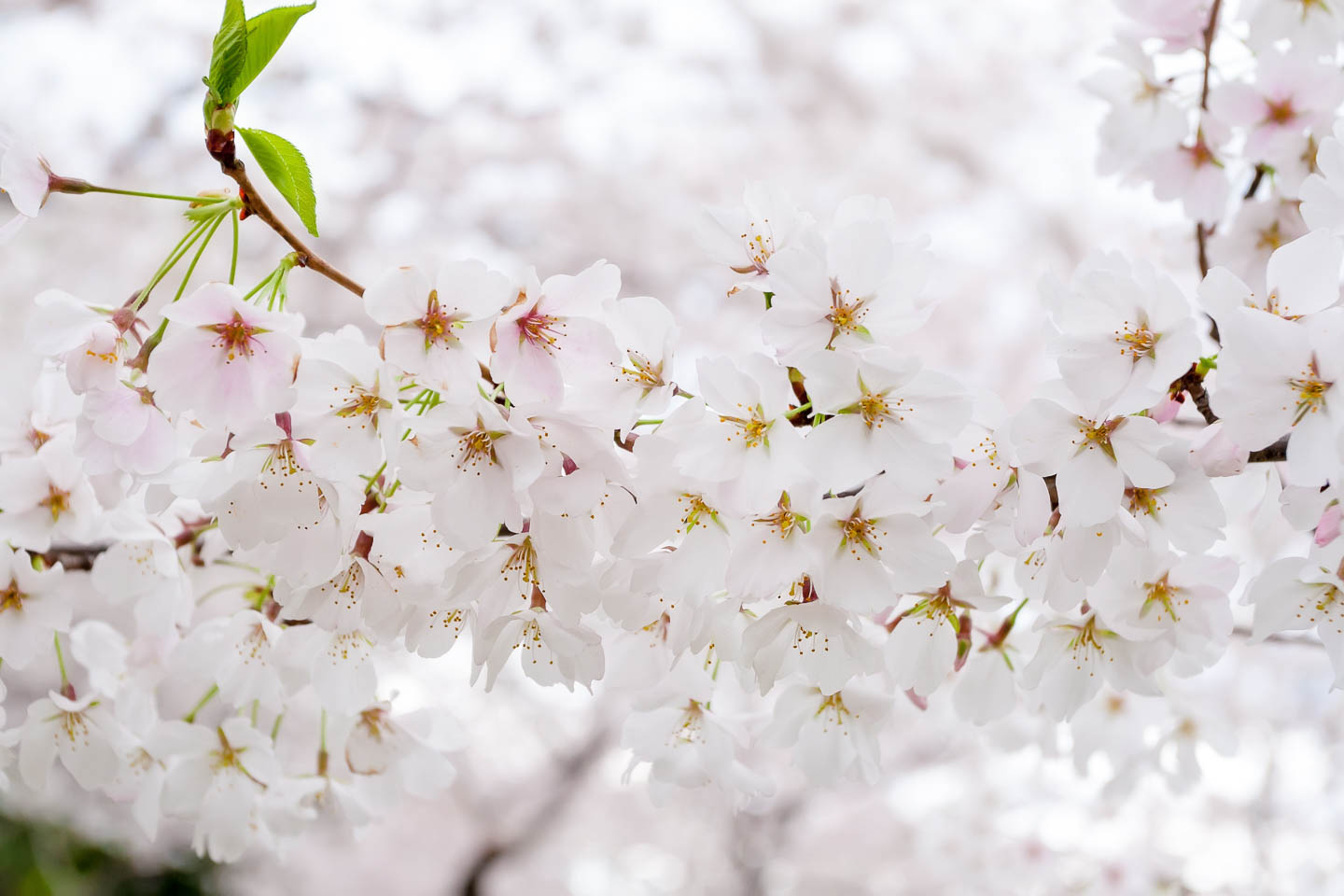
Zone: 5 to 8
Exposure: sun
Height: 25′ to 40′
Width: 20′ to 30′
Bloom time: early spring
Bloom color: white, pink
The Yoshino cherry tree is a deciduous hybrid introduced from Japan 1912 when a pair were gifted to the USA and planted in the Whitehouse lawn.
The clusters of almond scented, single petalled flowers, which appear before the dark-green leaves, contrast magnificently against the dark branches.
The leaves turn gold in the fall.
The fruit of this ornamental tree is too sour to be palatable for humans.
Plant Prunus in compost enriched, moist, well-drained soil. It will need supplemental watering during droughts because it is intolerant of prolonged dryness.
White Varieties: P. ‘Cascade Snow' — 25′ tall easy to grow and hardy
P. x ‘Snow Mountains — 12' semi weeping with orange/yellow fall leaves.
P. Ivensii — umbrella shaped weeping tree.
P. Shidare Yoshino ‘Washi-no-o' — graceful weeping branches
Source: shop.arborday.org/yoshino-cherry
Avoid: Bradford Pear (Pyrus Calleryana or Callery Pear)
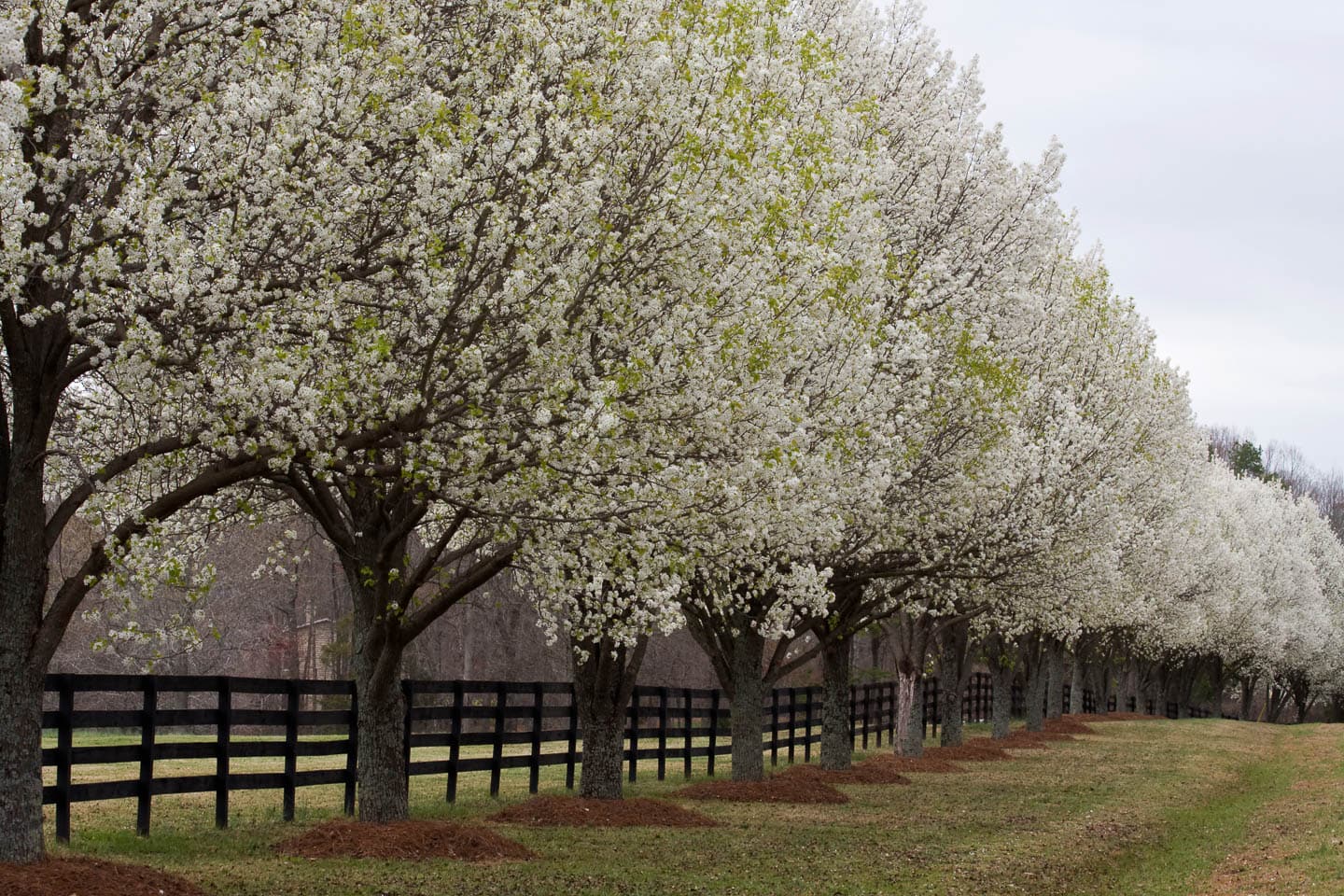
Zone: 5 to 9
Exposure: sun, part sun
Height: 30′ to 50′
Width: 20′ to 30′
Bloom time: early spring
Bloom color: white
Bradford pear is commonly planted as a front yard or boulevard tree in North American cities and subdivisions.
The only thing it has going for it is its beautiful clusters of white blooms in the spring.
Unfortunately, this tree has a number of problems, including:
- The shallow roots sucker into the lawn and surrounding area.
- It has a short life span of 15 to 25 years.
- As it gets older, the thin trunks split in high winds causing hazardous situations.
- Because of the seed distribution by birds eating the inedible small brown fruit, it is now considered invasive in many parts of North America.
Consider bypassing this tree for more desirable specimens, such as the others on this list.
Other early spring plants you might like
- Early spring white flowers (bulbs, perennials and shrubs)
- Bulbs and perennials with early spring blue flowers
- Purple flowering early spring plants
- Early spring yellow flowers
- The earliest blooming spring flowers
Have comments or question about our early spring white flowering trees? Tell us in the section below.
This post was originally published on March 17, 2022 but was updated with new content on November 23, 2024.

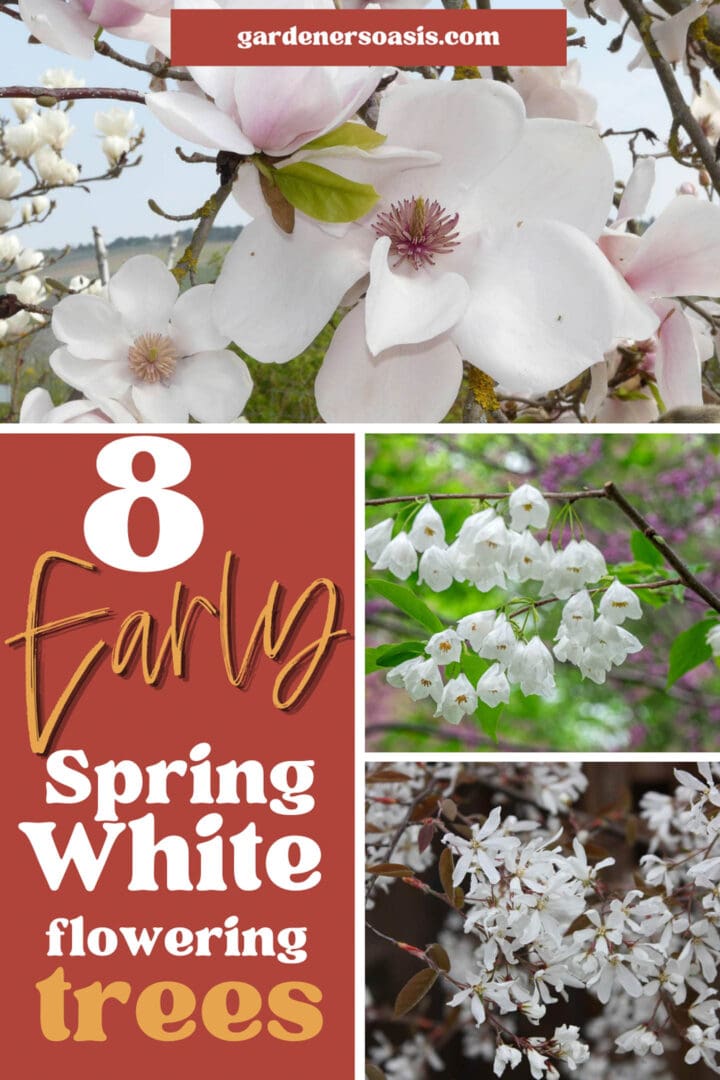
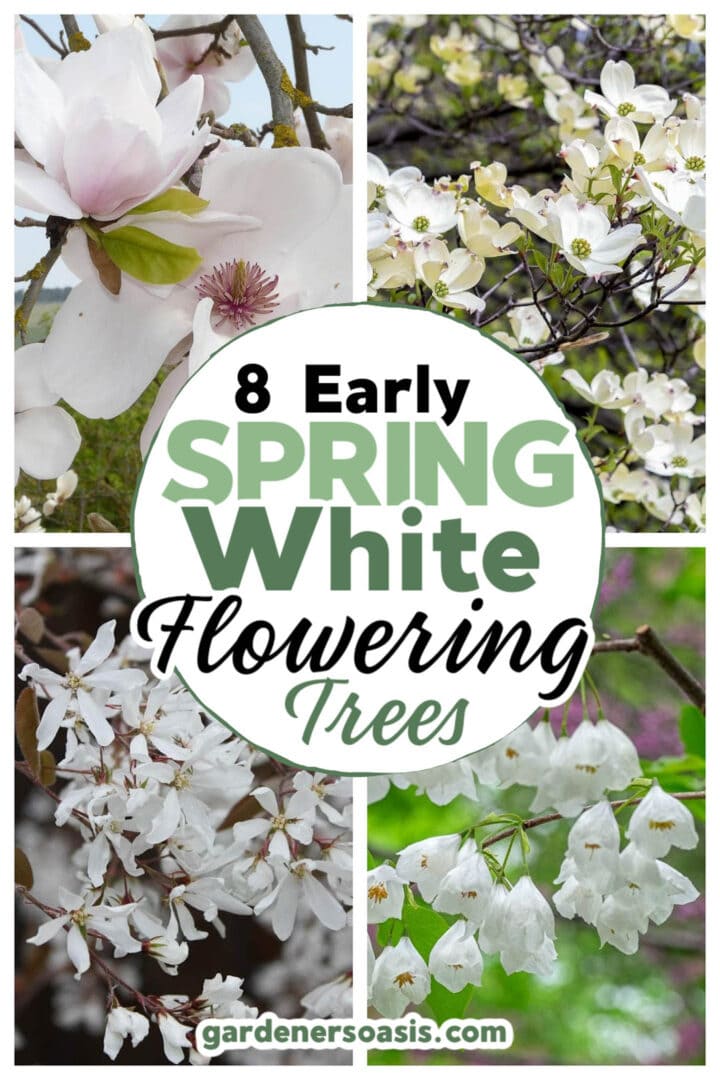
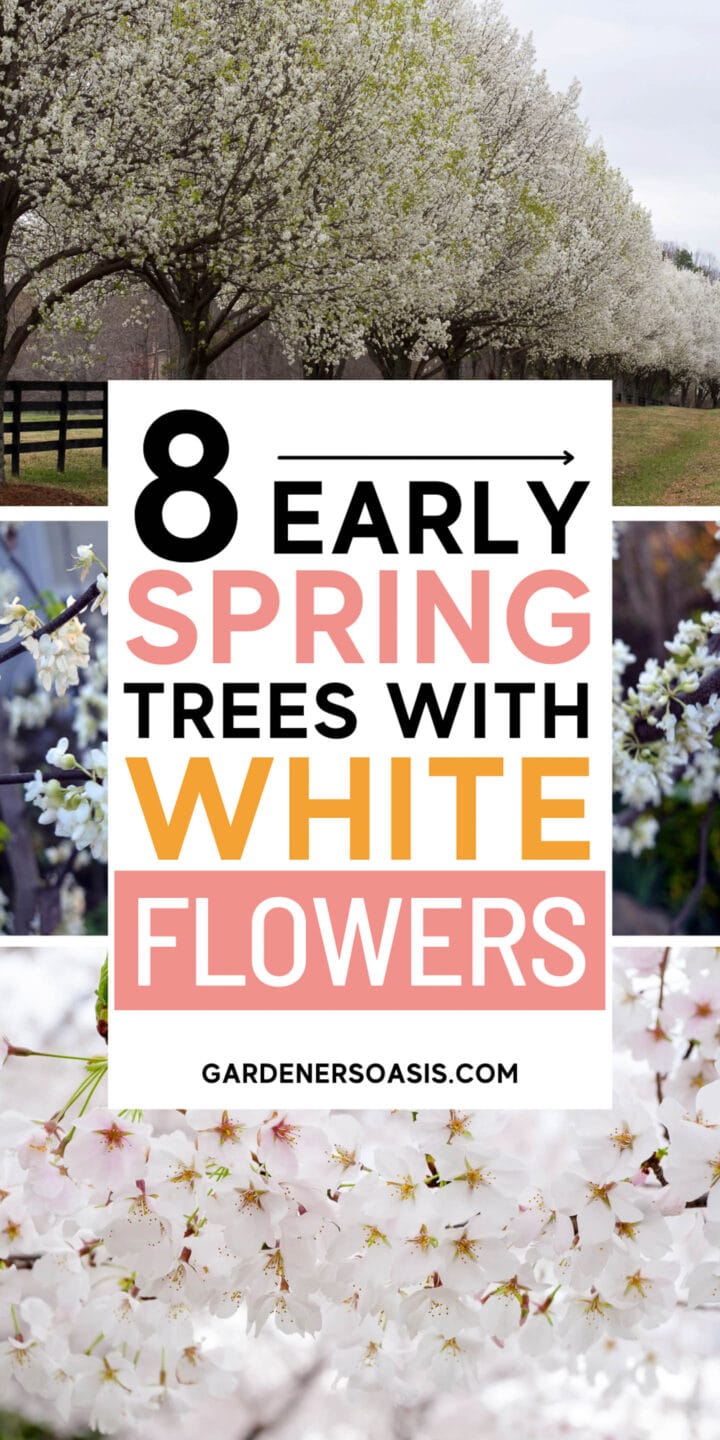
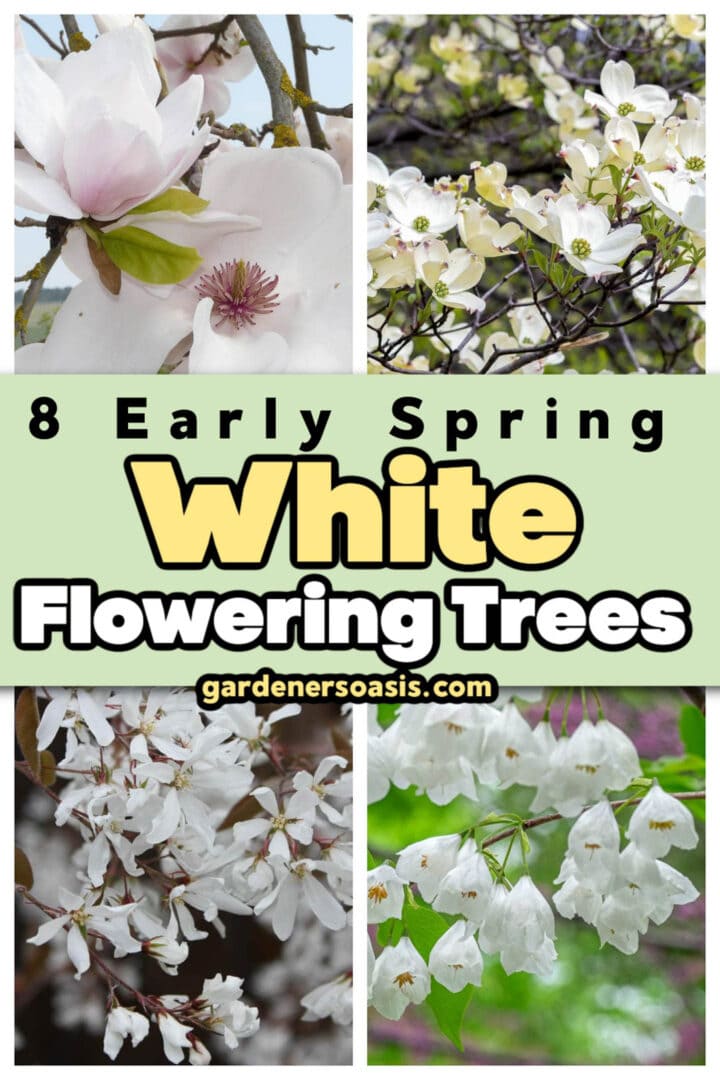
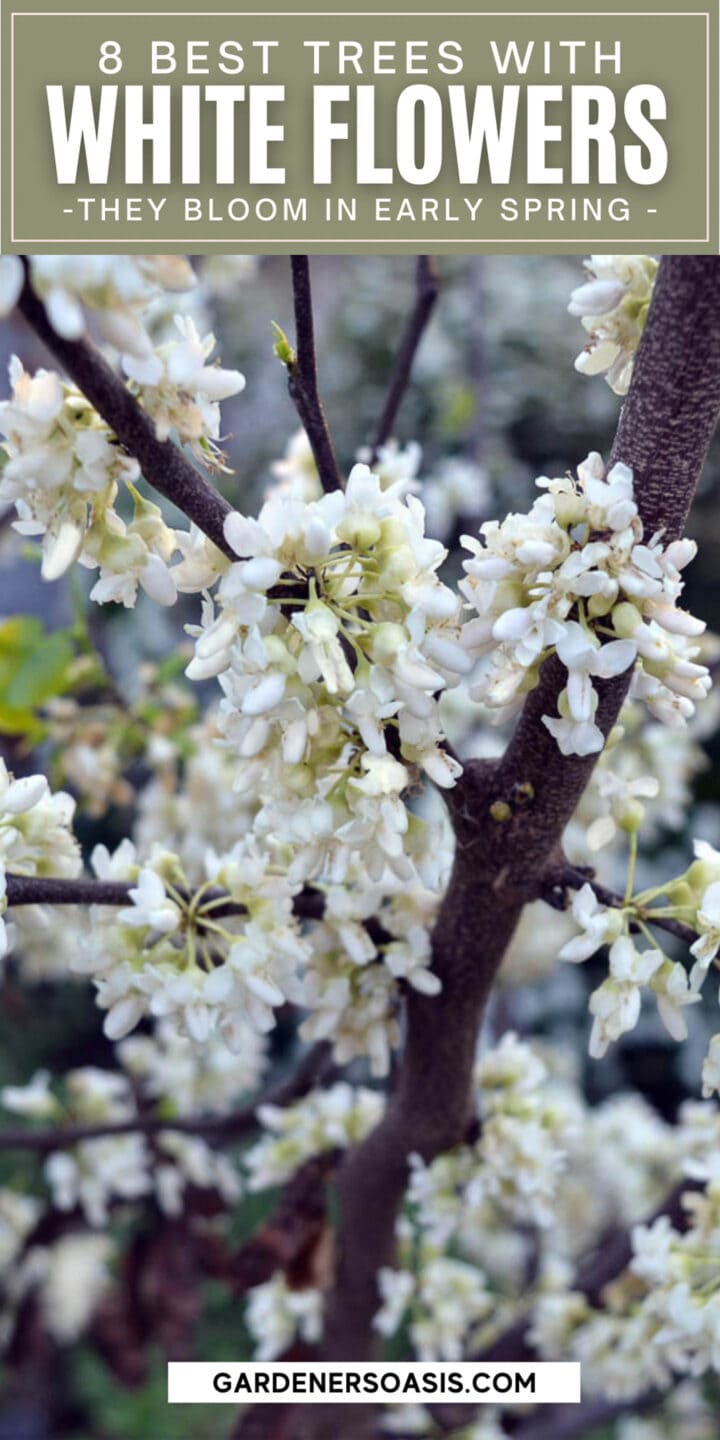
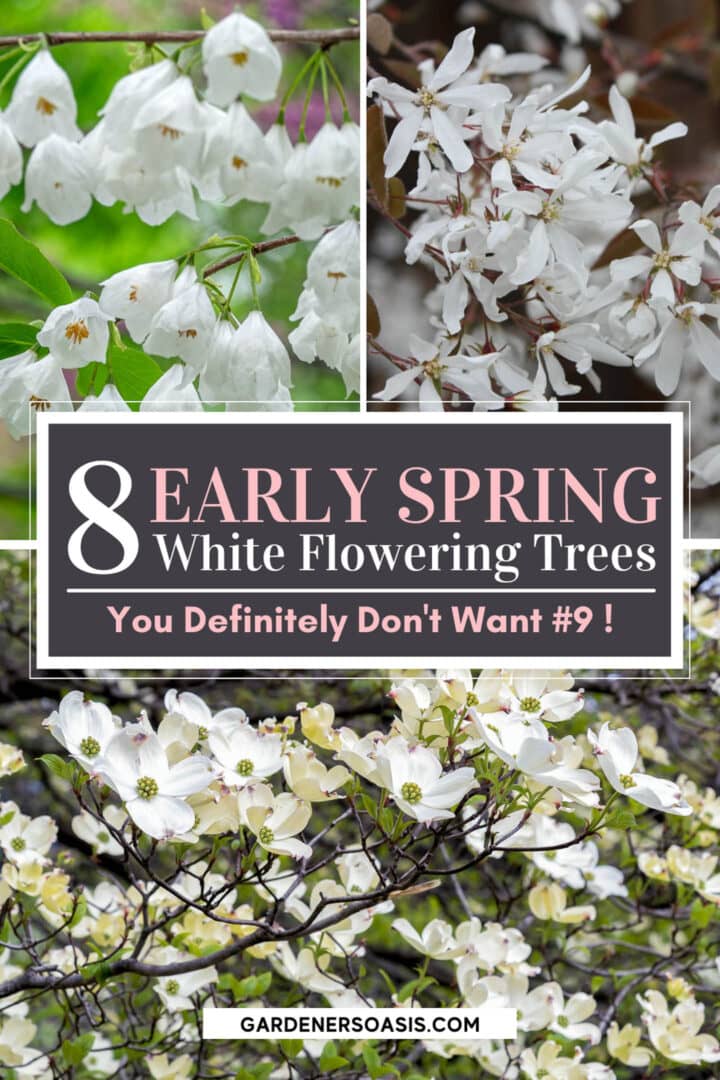

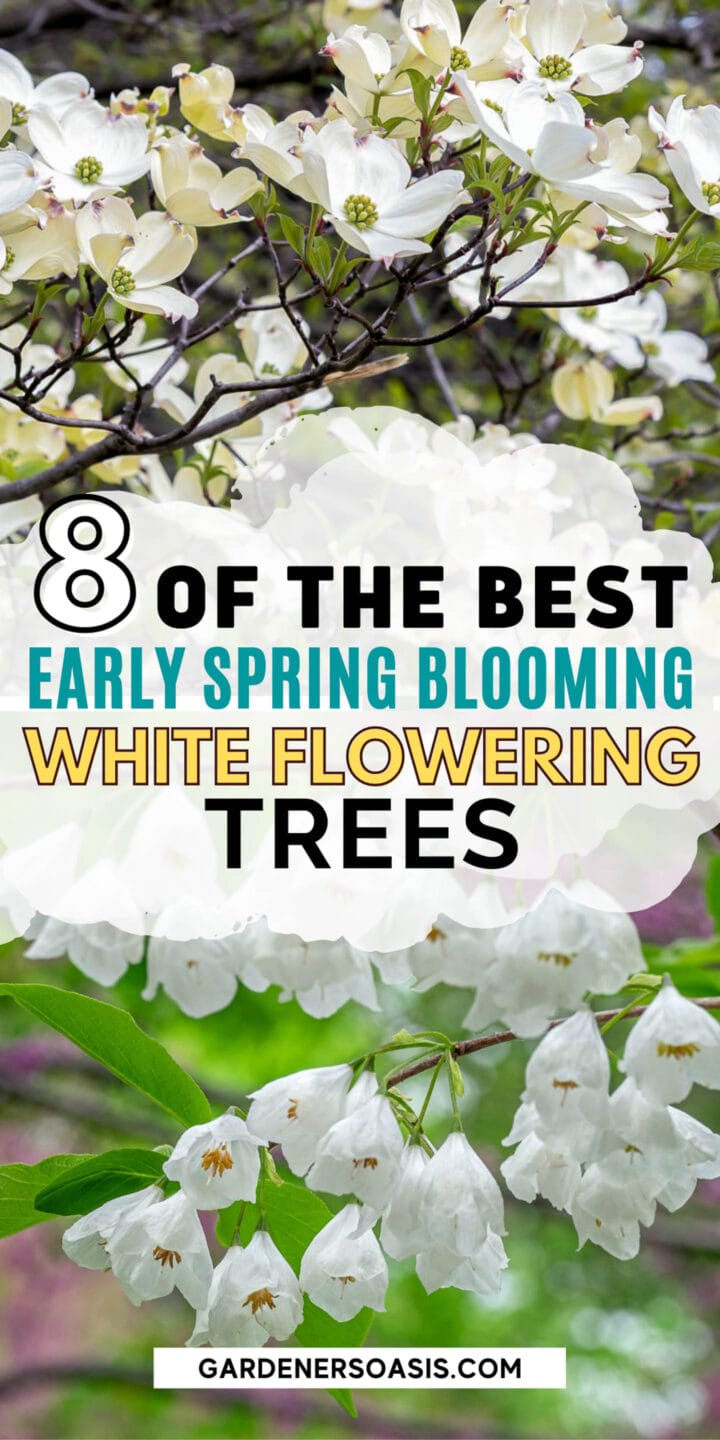
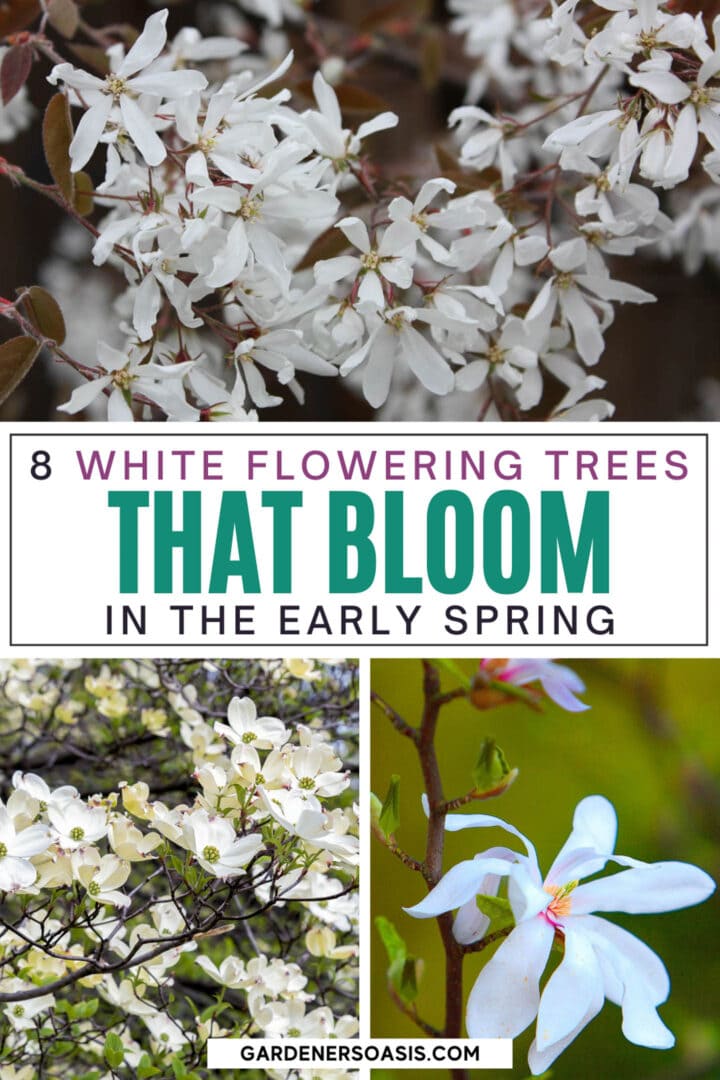
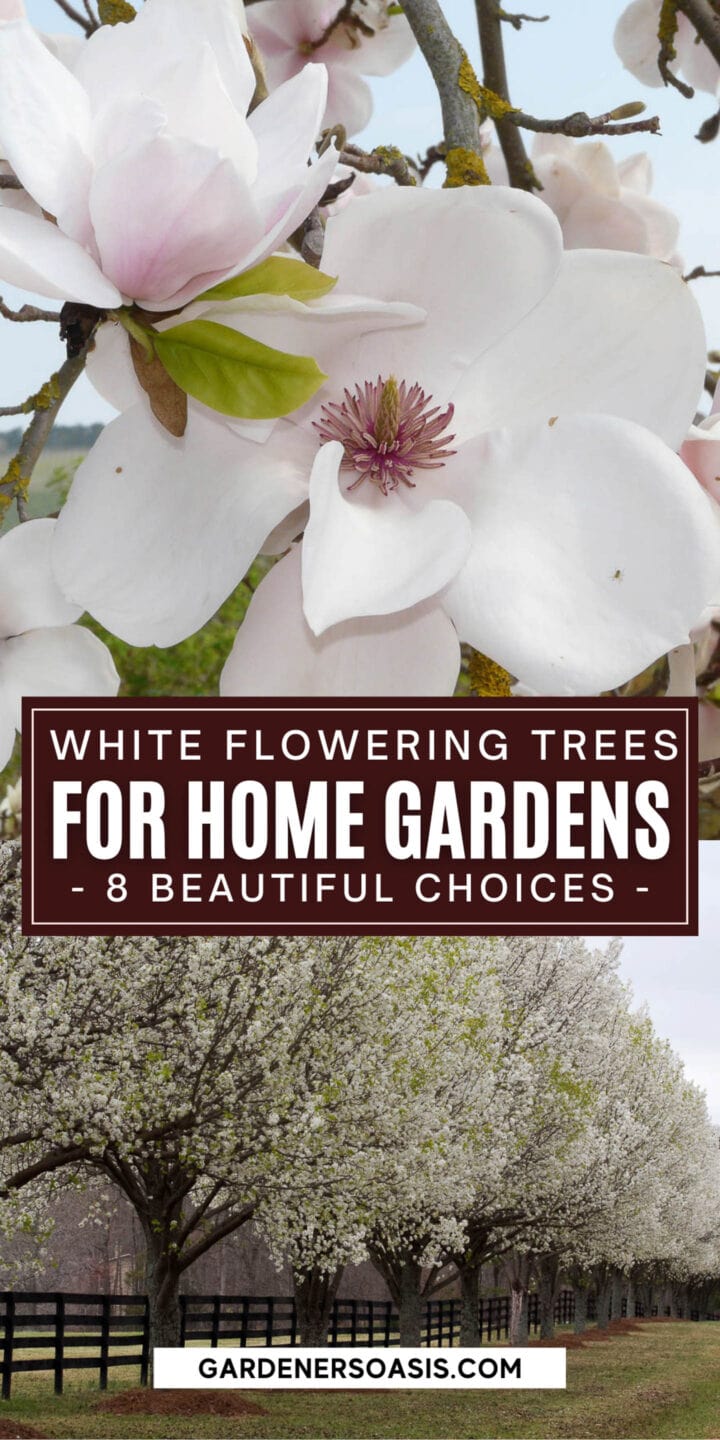
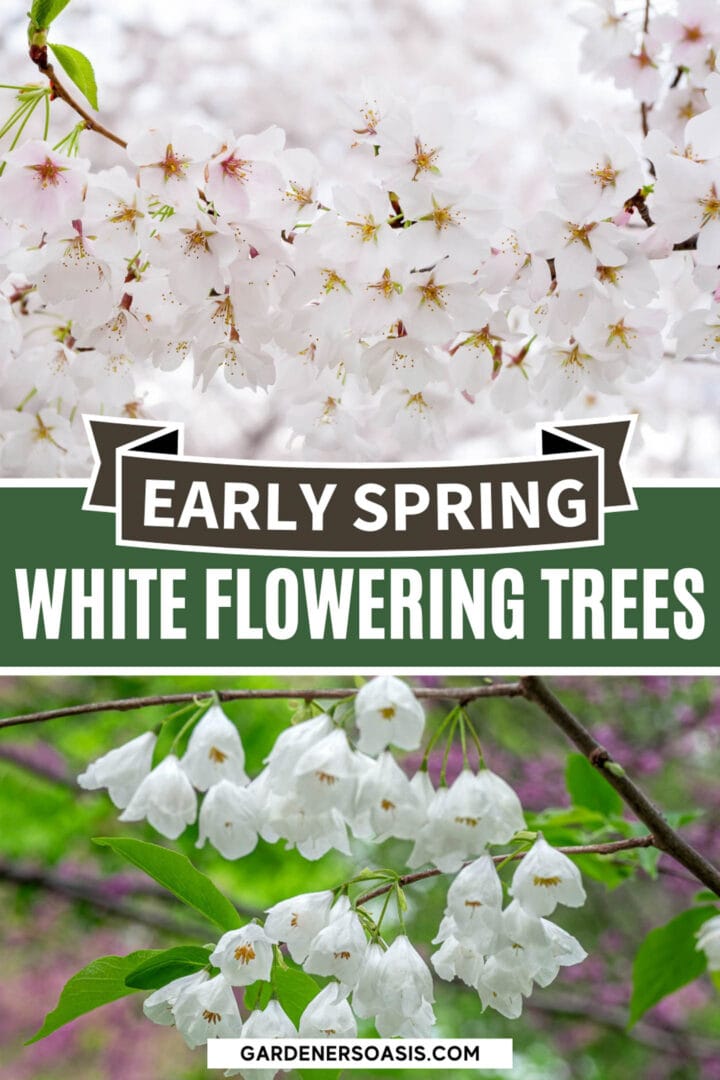

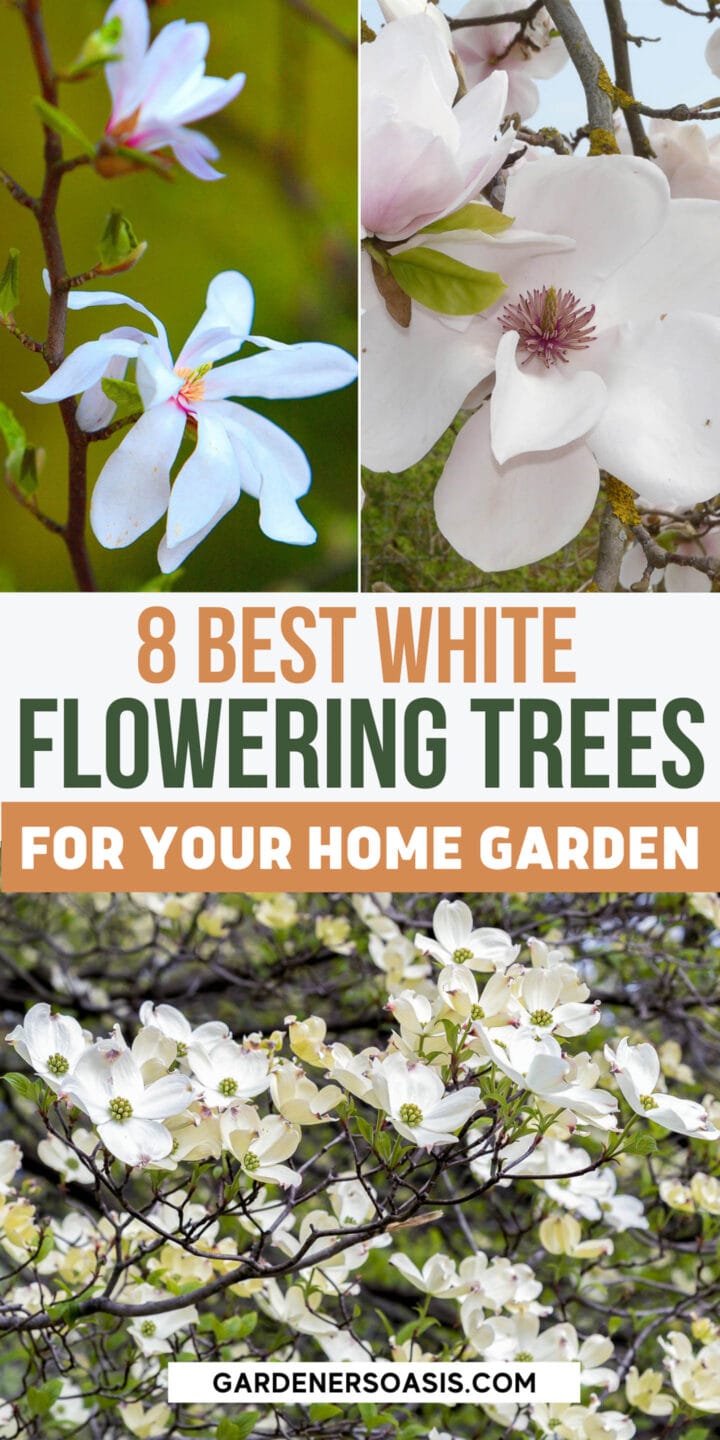
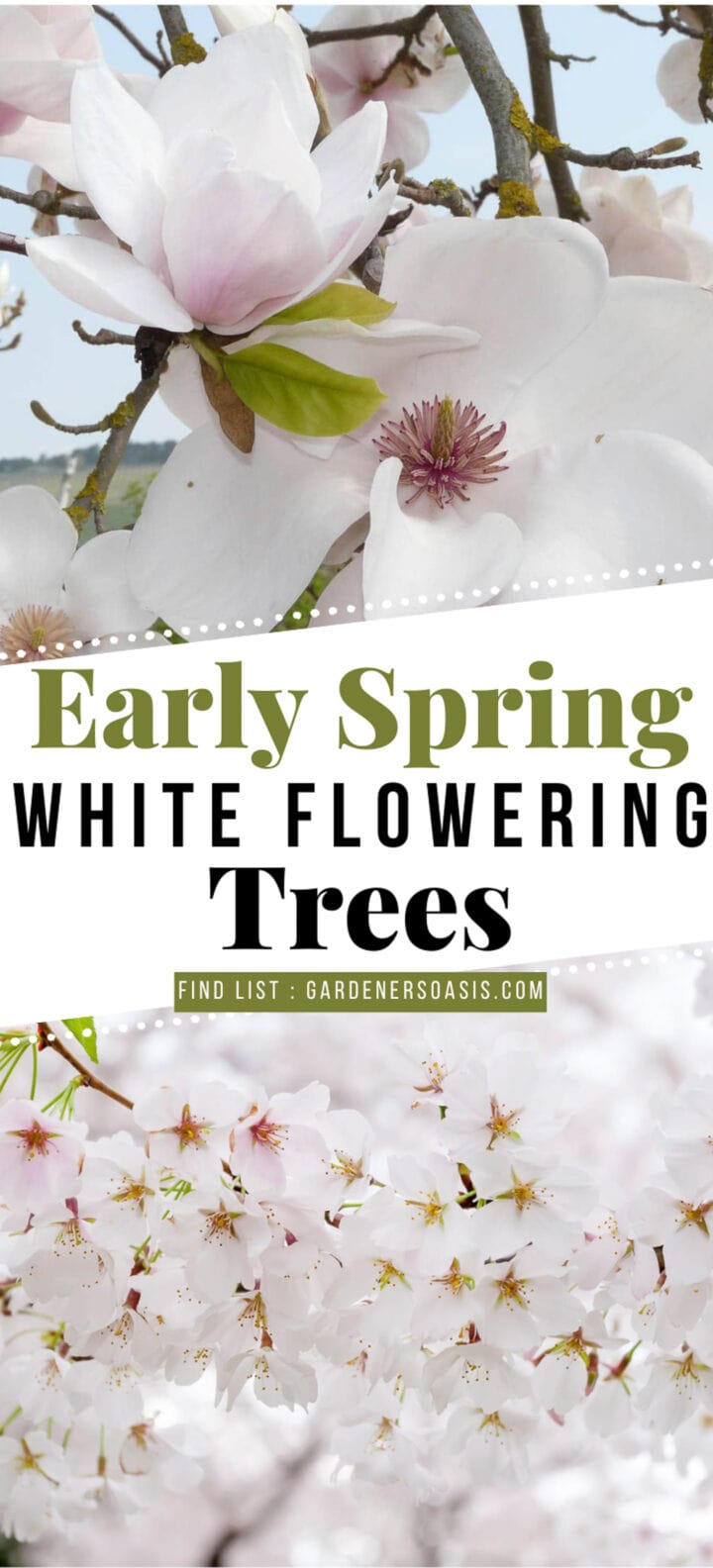
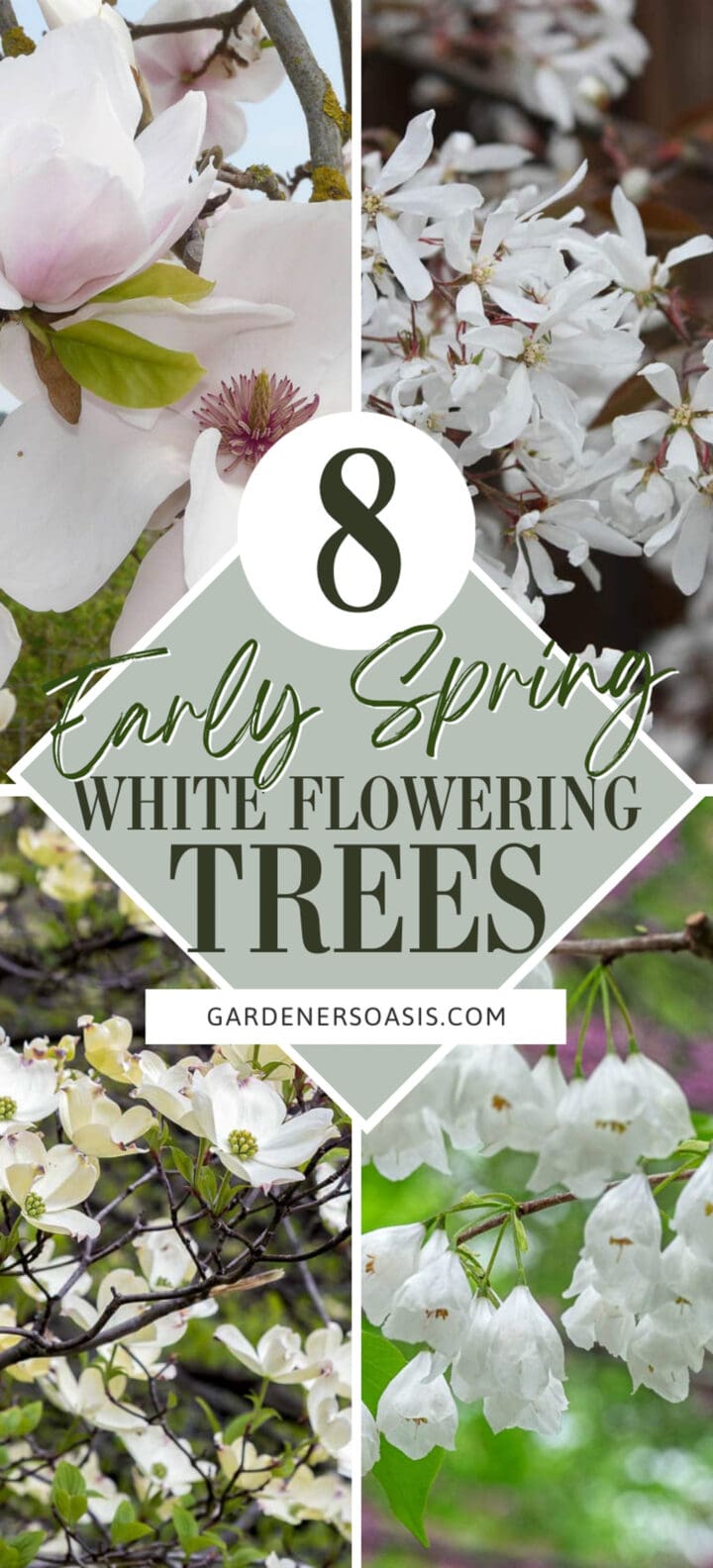
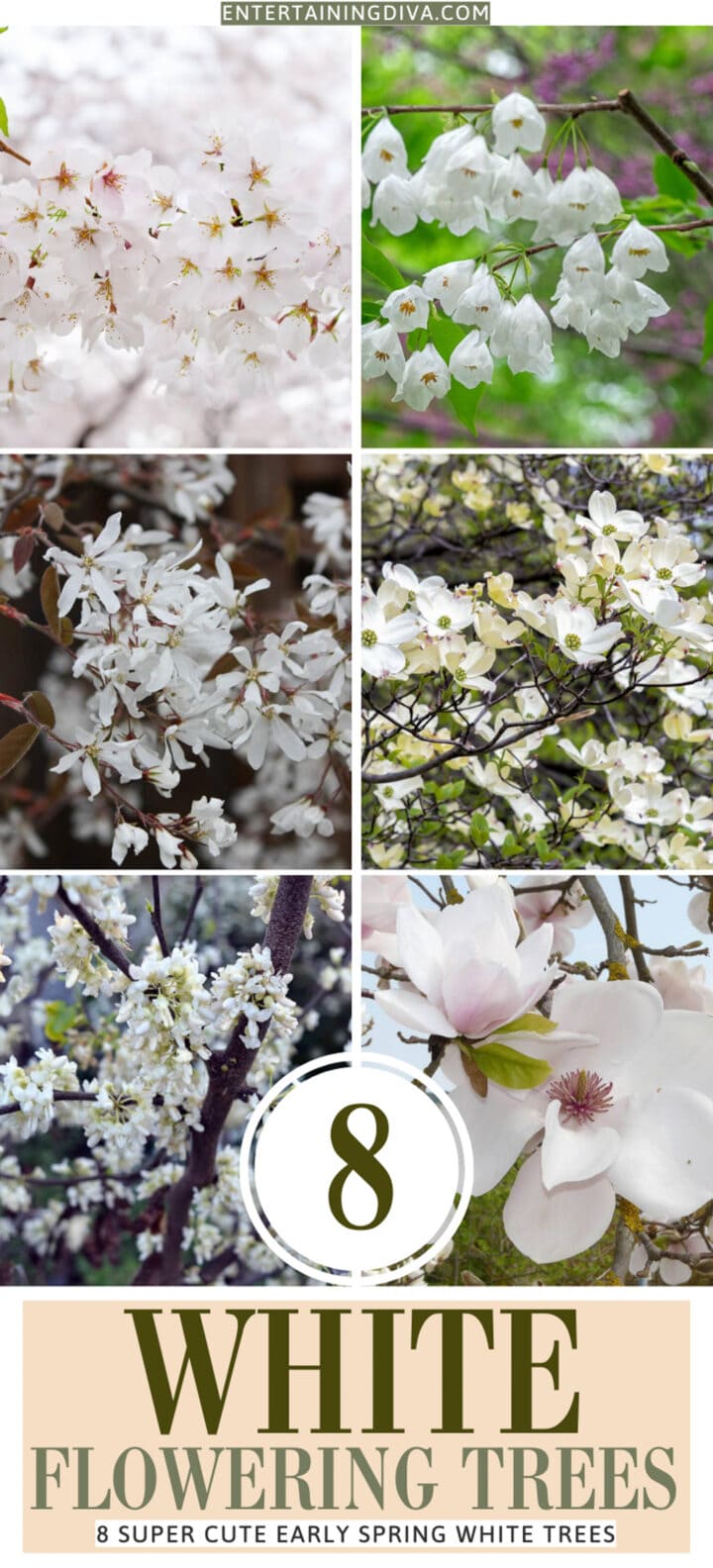
It’s late March/early April, and a 15-foot-high tree in a nearby backyard has sparse, large white flowers and NO LEAVES. What is it?!?!
I am guessing that it is some type of magnolia. I fine the app ‘plant snap’ useful in identifying plants.
You are right on about the Bradford pear. Wish I had known that before I planted it in my front yard . A storm came through this past winter and splintered the trunk about center of a 30ft tree. I wondered earlier why it was always having cracked stems falling or hanging on the tree. It was planted next to my septic field so that was not good either. Cost me $850 to have it cut to the ground, so that would have been money well spent on a better tree. Thanks for your information. I am looking for a new tree for the top of a mound which stands about 10′ high in my bak yard. I previously wanted fruit tree, but the deer destroyed it immediately. Used to have a big old chock cherry that rotted. Wish I could buy another. I liked it’s fruit as did the birds. Do any companies sell chock cherries?
Hi Marjorie…Choke cherries are a little hard to find. They’re a native plant so most nurseries don’t carry them. But I was able to find them at this online nursery: https://www.prairienursery.com/chokecherry-prunus-virginiana.html. Hopefully that helps.
Do not plant Bradford pear. Horrible invasive species. They smell bad & split easily. We had one split 4 way and one was on our house. Buy an Oak!
I love getting your emails and all the suggestions; however, I live in Mid Florida, zone 10A and I hardly find anything pertaining to this area. I know I could check the local nurseries, but it would be nice to see some information for those of us who live down in southern Florida. I am kinda done with palms. Thanks for you for sharing.
Sorry about that Linda…I do try to add plants from different zones but it can be hard to find things for the Florida area. I will see if I can find some reliable more Southern sources.